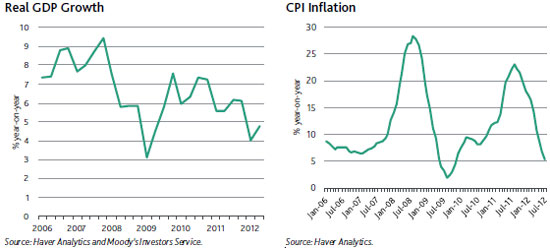International observers highly appreciate the inflation decrease in Vietnam, but keeps cautious with their predictions about the growth prospect and repeatedly express their worries about the bank bad debts.

The inflation and GDP growth rates
The reports released in late July and early August 2012 by JP Morgan Chase, HSBC and ANZ all emphasized the achievements of the government of Vietnam in curbing inflation. With the consumer price index (CPI) increase slowing down in recent months, Vietnam now has favorable conditions to slash bank loan interest rates to help stimulate economic growth.
“Vietnam at a glance” – the report by HSBC released on August 1, commented that the Vietnamese authorities have sent signals of getting ready to push the national economy ahead. In 2011, the measures to tighten credit were applied which has brought the desired effects. The CPI only increased by more than five percent in July, much lower than the sharpest increase of 23 percent seen in last August.
Other macroeconomic improvements such as the trade deficit decrease, stable dong/dollar exchange rate and foreign currency reserve increase have also recognized by the international institutions.
The trade deficit in the first seven months of the year dropped to 58 million dollars from 6 billion dollars of the same period of the last year. The dong/dollar exchange rate has been stable since the beginning of the year, while the foreign currency reserves have increased thanks to the trade deficit decrease and the strong foreign direct investment disbursement.
Moody’s report released on August 8 also said that the macroeconomic stability has been resumed thanks to the implementation of the measures to tighten the monetary policies since early 2011.
However, ANZ’s analysts still keep cautious about the Vietnam’s national economy, saying that the inflation decreases show the demand fall, which is the obstacle to the economic growth recovery.
The bank’s report showed the downward trend of the export turnover growth rate. The July’s export turnover growth rate dropped sharply to 3 percent, while it was 16.9 percent in June 2011.
Sharing the same view with ANZ, HSBC experts have warned that Vietnamese enterprises are now facing the low demand in both the domestic and foreign markets. The PMI, price management index, in July, announced by HSBC, has dropped to the deepest low since the index was first launched in April 2011. This shows that consumers have been no longer ready to spend money due to the high debts or the bad economic growth prospect.
JP Morgan Chase seems to be more optimistic in its report released in late July. The inflation rate in Vietnam, not including the fuel and food price increases, stayed at 0.6 percent in July in comparison with June, and 8 percent in comparison with the same period of the last year.
The credit growth and bad debts
HSBC and ANZ do not have the same viewpoint with JP Morgan Chase about Vietnam’s credit growth, saying that this is really a worrying problem of the Vietnam’s national economy at this moment.
HSBC’s report pointed out that the decline in the credit growth rate (less than one percent so far this year) reflects a lot of problems, including the weak domestic demand – a phenomenon of the structural weak points.
Regarding the bad debts, Moody commented that fragile factors of the Vietnamese banking system in the post- credit boom have been exposed.
Compiled by Win
